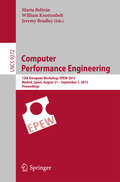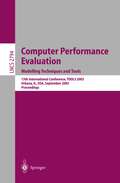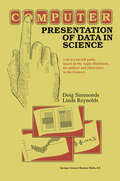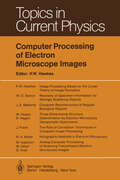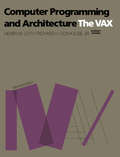- Table View
- List View
Computer Performance Engineering: 12th European Workshop, EPEW 2015, Madrid, Spain, August 31 - September 1, 2015, Proceedings (Lecture Notes in Computer Science #9272)
This book constitutes the refereed proceedings of the 12th European Workshop on Computer Performance Engineering, EPEW 2015, held in Madrid, Spain, in August/September 2015. The 19 papers presented in this volume were carefully reviewed and selected from 39 submissions. They were organized in topical sections named: applications; modelling techniques, software performance, and simulation techniques.
Computer Performance Engineering and Stochastic Modelling: 19th European Workshop, EPEW 2023, and 27th International Conference, ASMTA 2023, Florence, Italy, June 20–23, 2023, Proceedings (Lecture Notes in Computer Science #14231)
by Mauro Iacono Marco Scarpa Enrico Barbierato Salvatore Serrano Davide Cerotti Francesco LongoThis book constitutes the refereed proceedings of the 19th European Workshop on Computer Performance Engineering, EPEW 2023, and 27th International Conference on Analytical and Stochastic Modelling Techniques and Applications, ASMTA 2023, held in Florence, Italy, in June 2023.The 26 papers presented in this volume were carefully reviewed and selected from 35 submissions. The papers presented at the workshop reflect the diversity of modern performance engineering. The sessions covered a wide range of topics including robustness analysis, machine learning, edge and cloud computing, as well as more traditional topics on stochastic modelling, techniques and tools.
Computer Performance Evaluation: Modelling Techniques and Tools. 12th International Conference, TOOLS 2002 London, UK, April 14-17, 2002 Proceedings (Lecture Notes in Computer Science #2324)
by Tony Field Peter G. Harrison Jeremy Bradley Uli HarderComputer Performance Evaluation: Modelling Techniques and Tools (Lecture Notes in Computer Science #1469)
by Ramon Puigjaner Nunzio N. Savino Bartomeu SerraThe need to evaluate computer and communication systems performance and dependability is continuously growing as a consequence of both the increasing complexity of systems and the user requirements in terms of timing behaviour. The 10th International Conference on Modelling Techniques and Tools for C- puter Performance Evaluation, held in Palma in September 1998, was organised with the aim of creating a forum in which both theoreticians and practitioners could interchange recent techniques, tools, and experiences in these areas. This meeting follows the predecessor conferences of this series: 1984 Paris 1988 Palma 1994 Wien 1985 Sophia Antipolis 1991 Torino 1995 Heidelberg 1987 Paris 1992 Edinburgh 1997 Saint Malo The tradition of this conference series continued this year where many high quality papers were submitted. The Programme Committee had a di cult task in selecting the best papers. Many ne papers could not be included in the program due to space constraints. All accepted papers are included in this volume. Also, a set of submissions describing performance modelling tools was transformed into tool presentations and demonstrations. A brief description of these tools is included in this volume. The following table gives the overall statistics for the submissions.
Computer Performance Evaluation and Benchmarking: SPEC Benchmark Workshop 2009, Austin, TX, USA, January 25, 2009, Proceedings (Lecture Notes in Computer Science #5419)
by David KaeliThis book constitutes the proceedings of the SPEC Benchmark Workshop 2009 held in Austin, Texas, USA on January 25th, 2009. The 9 papers presented were carefully selected and reviewed for inclusion in the book. The result is a collection of high-quality papers discussing current issues in the area of benchmarking research and technology. The topics covered are: benchmark suites, CPU benchmarking, power/thermal benchmarking, and modeling and sampling techniques.
Computer Performance Evaluation. Modelling Techniques and Tools: 11th International Conference, TOOLS 2000 Schaumburg, IL, USA, March 25-31, 2000 Proceedings (Lecture Notes in Computer Science #1786)
by Boudewijn R. Haverkort Henrik C. Bohnenkamp Connie U. SmithComputer Performance Evaluation. Modelling Techniques and Tools: 13th International Conference, TOOLS 2003, Urbana, IL, USA, September 2-5, 2003, Proceedings (Lecture Notes in Computer Science #2794)
by Peter Kemper William H. SandersWe are pleased to present the proceedings of Performance TOOLS 2003, the 13th International Conference on Modelling Techniques and Tools for Computer Performance Evaluation. The series of TOOLS conferences has provided a forum for our community of performance engineers with all their diverse interests. TOOLS 2003, held in Urbana, Illinois during September 2–5, 2003, was the most recent meeting of the series, which in the past has been held in the following cities: 1984 Paris 1992 Edinburgh 2000 Chicago 1985 Sophia-Antipolis 1994 Vienna 2002 London 1987 Paris 1995 Heidelberg 2003 Urbana 1988 Palma 1997 Saint Malo 1991 Turin 1998 Palma TheproceedingsoftheTOOLSconferenceshavebeenpublishedbySpringer- Verlag in its LNCS series since 1994. TOOLS2003wasthesecondconferenceintheseriestobeheldinthestateof Illinois, USA. It was one of four component conferences that met together under the umbrella of the 2003 Illinois Multiconference on Measurement, Modelling, and Evaluation of Computer-Communication Systems. Other conferences held inconjunctionwithTOOLS2003werethe10thInternationalWorkshoponPetri Nets and Performance Models (PNPM 2003), the International Conference on the Numerical Solution of Markov Chains (NSMC 2003), and the 6th Inter- tional Workshop on Performability Modeling of Computer and Communication Systems (PMCCS-6). The format allowed for a number of joint components in the programs: the three keynote speakers, the tool demonstrations, the tutorials, and the social events were all shared by the participants of the multiconference. Moreover, the PNPM, TOOLS, and NSMC tracks of the multiconference ran concurrently, so that attendees could choose to attend whichever sessions of those component conferences they wished.
Computer Performance Optimization: Systems - Applications - Processes
by Wolfgang W. OsterhageComputing power performance was important at times when hardware was still expensive, because hardware had to be put to the best use. Later on this criterion was no longer critical, since hardware had become inexpensive. Meanwhile, however, people have realized that performance again plays a significant role, because of the major drain on system resources involved in developing complex applications. This book distinguishes between three levels of performance optimization: the system level, application level and business processes level. On each, optimizations can be achieved and cost-cutting potentials can be identified. The book presents the relevant theoretical background and measuring methods as well as proposed solutions. An evaluation of network monitors and checklists rounds out the work.
Computer Presentation of Data in Science: a do-it-yourself guide, based on the Apple Macintosh, for authors and illustrators in the Sciences
by D. Simmonds L. ReynoldsBooks about printing written for printers or would-be printers go back over 300 years. The earliest of them were almost exclusively concerned with books; this century, however, there has been more emphasis on other kinds of documents, and particularly their design. But no shift in document production has been more sudden than the one that has happened most recently. ConSequently, the last five years have witnessed a substantial movement away from books written for professionals to ones whose aim is to help would-be authors produce their own documents. The opportunities for authors to do this have been opened up by the advent of desktop publishing (a term coined as recently as 1984). As most exponents of desktop publishing have come to realise, the term is something of a misnomer because the provision of facilities that allow authors to produce their own material for publishing is not quite the same thing as publish ing. Nevertheless, it has been useful in focussing attention on author-produced documents, and what might be described as the democratisation of document production. This book is different from others in the field. Its target audience is the busy scientist engaged in teaching or research who uses computers in the ordinary course of work. The world of scientific publishing is rapidly moving towards the day when journals will expect contributions from authors on disc, or even by direct transfer of data from the author's computer to the output device of an editor via telephone and satellite.
Computer Processing of Electron Microscope Images (Topics in Current Physics #13)
by J. Frank P. W. Hawkes R. Hegerl W. Hoppe M. S. Isaacson D. Kopf J. E. Mellema W. O. Saxton M. Utlaut R. H. WadeTowards the end of the 1960s, a number of quite different circumstances combined to launch a period of intense activity in the digital processing of electron micro graphs. First, many years of work on correcting the resolution-limiting aberrations of electron microscope objectives had shown that these optical impediments to very high resolution could indeed be overcome, but only at the cost of immense exper imental difficulty; thanks largely to the theoretical work of K. -J. Hanszen and his colleagues and to the experimental work of F. Thon, the notions of transfer func tions were beginning to supplant or complement the concepts of geometrical optics in electron optical thinking; and finally, large fast computers, capable of manipu lating big image matrices in a reasonable time, were widely accessible. Thus the idea that recorded electron microscope images could be improved in some way or rendered more informative by subsequent computer processing gradually gained ground. At first, most effort was concentrated on three-dimensional reconstruction, particu larly of specimens with natural symmetry that could be exploited, and on linear operations on weakly scattering specimens (Chap. l). In 1973, however, R. W. Gerchberg and W. O. Saxton described an iterative algorithm that in principle yielded the phase and amplitude of the electron wave emerging from a strongly scattering speci men.
Computer Processing of Oriental Languages. Beyond the Orient: 21st International Conference, ICCPOL 2006, Singapore, December 17-19, 2006, Proceedings (Lecture Notes in Computer Science #4285)
by Kam-Fai Wong Min Zhang Yuji Matsumoto Richard SproatThis book constitutes the thoroughly refereed proceedings of the 21st International Conference on Computer Processing of Oriental Languages, ICCPOL 2006, held in Singapore in December 2006, co-located with ISCSLP 2006, the 5th International Symposium on Chinese Spoken Language Processing. Coverage includes information retrieval, machine translation, word segmentation, abbreviation expansion, writing-system issues, semantics, and lexical resources.
Computer Processing of Oriental Languages. Language Technology for the Knowledge-based Economy: 22nd International Conference, ICCPOL 2009, Hong Kong, March 26-27, 2009. Proceedings (Lecture Notes in Computer Science #5459)
by Wenjie Li Diego Mollá-AliodThe International Conference on the Computer Processing of Oriental L- guages(ICCPOL)seriesishostedbytheChineseandOrientalLanguagesSociety (COLCS),aninternationalsocietyfoundedin1975.RecentICCPOLeventshave been held in Hong Kong (1997), Tokushima, Japan (1999), Seoul, Korea (2001), Shenyang, China (2003) and Singapore (2006). This volume presents the proceedings of the 22nd International Conference ontheComputerProcessingofOrientalLanguages(ICCPOL2009)heldinHong Kong, March 26-27, 2009. We received 63 submissions and all the papers went through a blind review process by members of the Program Committee. After careful discussion, 25 of them were selected for oral presentation and 15 for poster presentation. The accepted papers covered a variety of topics in natural language processing and its applications, including word segmentation, phrase and term extraction, chunking and parsing, semantic labelling, opinion mining, ontology construction, machine translation, information extraction, document summarization and so on. On behalf of the Program Committee, we would like to thank all authors of submitted papers for their support. We wish to extend our appreciation to the Program Committee members and additional external reviewers for their tremendous e?ort and excellent reviews. We gratefully acknowledge the Or- nizing Committee and Publication Committee members for their generous c- tribution to the success of the conference. We also thank the Asian Federation of Natural Language Processing (AFNLP), the Department of Computing, The Hong Kong Polytechnic University, Hong Kong, the Department of Systems - gineering and Engineering Management, The Chinese University of Hong Kong, Hong Kong, and the Centre for Language Technology, Macquarie University, Australia for their valuable support.
Computer Programming: Made Simple
by J. MaynardComputer Programming: Made Simple, New Edition focuses on the processes, principles, methodologies, techniques, and approaches involved in computer programming. The publication first takes a look at the introduction to computer structure, backing store, input, and output devices, and logic and flowcharting. Discussions focus on flowcharting, file organization, sequencing, and security, magnetic disc devices, optical character recognition, keyboard, encoders, optical mark reading, input and output unit, and backing store. The manuscript then ponders on operating systems, data and numbers, introduction to COBOL, and word types and constants. The text examines arithmetic statements, MULTIPLY and DIVIDE statements, program control, data classes in COBOL, editing, and data transfer. Topics include READ and WRITE statements, types of editing, PICTURE clause, file labeling, BLOCK CONTAINS clause, PERFORM and STOP statements, and MULTIPLY, DIVIDE, and COMPUTE statements. The book also tackles microprocessors, arrays, and subscripts, loops and subroutines, and program control. The publication is a dependable source of data for computer programmers and researchers interested in computer programming.
Computer Programming and Architecture: The Vax
by Henry Levy Richard EckhouseTakes a unique systems approach to programming and architecture of the VAX Using the VAX as a detailed example, the first half of this book offers a complete course in assembly language programming. The second describes higher-level systems issues in computer architecture. Highlights include the VAX assembler and debugger, other modern architectures such as RISCs, multiprocessing and parallel computing, microprogramming, caches and translation buffers, and an appendix on the Berkeley UNIX assembler.
Computer Programming for Absolute Beginners: Learn essential computer science concepts and coding techniques to kick-start your programming career
by Joakim WassbergGet to grips with the building blocks of programming languages and get started on your programming journey without a computer science degree Key Features Understand the fundamentals of a computer program and apply the concepts you learn to different programming languages Gain the confidence to write your first computer program Explore tips, techniques, and best practices to start coding like a professional programmer Book Description Learning how to code has many advantages, and gaining the right programming skills can have a massive impact on what you can do with your current skill set and the way you advance in your career. This book will be your guide to learning computer programming easily, helping you overcome the difficulties in understanding the major constructs in any mainstream programming language. Computer Programming for Absolute Beginners starts by taking you through the building blocks of any programming language with thorough explanations and relevant examples in pseudocode. You'll understand the relationship between computer programs and programming languages and how code is executed on the computer. The book then focuses on the different types of applications that you can create with your programming knowledge. You'll delve into programming constructs, learning all about statements, operators, variables, and data types. As you advance, you'll see how to control the flow of your programs using control structures and reuse your code using functions. Finally, you'll explore best practices that will help you write code like a pro. By the end of this book, you'll be prepared to learn any programming language and take control of your career by adding coding to your skill set. What you will learn Get to grips with basic programming language concepts such as variables, loops, selection and functions Understand what a program is and how the computer executes it Explore different programming languages and learn about the relationship between source code and executable code Solve problems using various paradigms such as procedural programming, object oriented programming, and functional programming Write high-quality code using several coding conventions and best practices Become well-versed with how to track and fix bugs in your programs Who this book is for This book is for beginners who have never programmed before and are looking to enter the world of programming. This includes anyone who is about to start studying programming and wants a head start, or simply wants to learn how to program on their own.
Computer Programming for Beginners: A Step-By-Step Guide
by Murali ChemuturiThis book aims to capture the fundamentals of computer programming without tying the topic to any specific programming language. To the best of the authors’ knowledge there is no such book in the market.
Computer Programming for Beginners: A Step-By-Step Guide
by Murali ChemuturiThis book aims to capture the fundamentals of computer programming without tying the topic to any specific programming language. To the best of the authors’ knowledge there is no such book in the market.
Computer Programming in C for Beginners
by Avelino J. GonzalezThis textbook is an ideal introduction in college courses or self-study for learning computer programming using the C language. Written for those with minimal or no programming experience, Computer Programming in C for Beginners offers a heavily guided, hands-on approach that enables the reader to quickly start programming, and then progresses to cover the major concepts of C programming that are critical for an early stage programmer to know and understand. While the progression of topics is conventional, their treatment is innovative and designed for rapid understanding of the many concepts in C that have traditionally proven difficult for beginners, such as variable typing and scope, function definition, passing by value, pointers, passing by reference, arrays, structures, basic memory management, dynamic memory allocation, and linked lists, as well as an introductory treatment of searching and sorting algorithms. Written in an informal but clear narrative, the book uses extensive examples throughout and provides detailed guidance on how to write the C code to achieve the objectives of the example problems. Derived from the author’s many years of teaching hands-on college courses, it encourages the reader to follow along by programming the progressively more complex exercise programs presented. In some sections, errors are purposely inserted into the code to teach the reader about the common pitfalls of programming in general, and the C language in particular.
Computer Programming Languages in Practice: Made Simple Computerbooks
by C. A. HofeditzComputer Programming Languages in Practice provides an overview of various computer programming languages. The book begins with the fundamentals: what programs are; how they are planned and organized; what elements of the computer the programmer controls; flowcharting; and how computer data is organized. It then discusses material common to all languages, including the entry program, the compiler, the run-time system, syntax diagrams, and coding forms. The largest portion of this book is devoted to two very popular languages—BASIC and COBOL. It provides a brief history of the language's development and use; a description of how the programming system is organized; its major components, divisions of instructions, and a description of its instruction set (instruction-by-instruction); how a program is written, including a sample program; and a self-test, including exercises in which programming statements must be written. The final chapter discusses those languages which the reader is less likely to use but should know about. Included are descriptions of FORTRAN and RPG II.
Computer Publishing: Grundlagen und Anwendungen (Edition PAGE)
by Ulrich SchmittComputer Publishing für die Praxis ist das Motto des Buches, mit dem Sie selbst anspruchsvolle Prospekte, Zeitschriften oder Bücher leicht erstellen können. Neben tagesaktuellem Anwenderwissen liefert es Ihnen Basisinformationen, die auch mit zukünftigen Hard- und Softwareversionen nicht veralten. Die maßgeschneiderte Arbeitshilfe für jeden Praktiker in Druckvorstufe, Druckindustrie, Design und Entwurf!
Computer Recognition Systems: Proceedings of 4th International Conference on Computer Recognition Systems CORES'05 (Advances in Intelligent and Soft Computing #30)
by Michal Wozniak Andrzej Zolnierek Marek Kurzynski Edward Puchalath This book contains papers accepted for presentation at the 4 International Conference on Computer Recognition Systems CORES'05, May 22-25, 2005, Rydzyna Castle (Poland), This conference is a continuation of a series of con ferences on similar topics (KOSYR) organized each second year, since 1999, by the Chair of Systems and Computer Networks, Wroclaw University of Tech nology. An increasing interest to those conferences paid not only by home but also by foreign participants inspired the organizers to transform them into conferences of international range. Our expectations that the community of specialists in computer recognizing systems will find CORES'05 a proper form of maintaining the tradition of the former conferences have been confirmed by a large number of submitted papers. Alas, organizational constraints caused a necessity to narrow the acceptance criteria so that only 100 papers have been finally included into the conference program. The area covered by accepted papers is still very large and it shows how vivacious is scientific activity in the domain of computer recognition methods and systems. It contains vari ous theoretical approaches to the recognition problem based on mathematical statistics, fuzzy sets, morphological methods, wavelets, syntactic methods, genetic algorithms, artificial neural networks, ontological models, etc. Most attention is still paid to visual objects recognition; however, acoustic, tex tual and other objects are also considered. Among application areas medical problems are in majority; recognition of faces, speech signals and textual in formation processing methods being also investigated.
Computer Recognition Systems 2 (Advances in Intelligent and Soft Computing #45)
by Michal Wozniak Andrzej Zolnierek Marek Kurzynski Edward PuchalaThis book presents the results of the 5th International Conference on Computer Recognition Systems CORES’07 held 22-25 October 2007 in Hotel Tumski, Wroclaw, Poland. It brings together original research results in both methodological issues and different application areas of pattern recognition. The contributions cover all topics in pattern recognition including, for example, classification and interpretation of text, video, and voice.
Computer Recognition Systems 3 (Advances in Intelligent and Soft Computing #57)
by Marek Kurzynski Michal WozniakComputer Recognition Systems 4 (Advances in Intelligent and Soft Computing #95)
by Robert Burduk Marek Kurzynski Michal Wozniak Andrzej ZolnierekThe computer recognition systems are nowadays one of the most promising directions in artificial intelligence. This book is the most comprehensive study of this field. It contains a collection of 78 carefully selected articles contributed by experts of pattern recognition. It reports on current research with respect to both methodology and applications. In particular, it includes the following sections:Biometrics,Features, learning and classifiers,Image processing and computer vision,Knowledge acquisition based on reasoning methodsMedical applications,Miscellaneous applications,This book is a great reference tool for scientists who deal with the problems of designing computer pattern recognition systems. Its target readers can be as well researchers as students of computer science, artificial intelligence or robotics.
Computer Related Occupational Deviance: Ein Mehr-Ebenen-Modell zur Erklärung und Prävention
by David GodschalkDavid Godschalk untersucht Ursachen und Entstehungsbedingungen von Rechtsverstößen wie Computersabotage, Betrug und Geheimnisverrat in Firmen und von anderen, nicht kriminalisierten, unternehmensschädigenden Verhaltensweisen. Er zeigt, dass steigende Komplexität und Spezifität organisationsinterner Strukturen und Prozesse infolge von Individualisierung, Rationalisierung und Technologisierung der Unternehmensumwelt in Verbindung mit rational und opportunistisch agierenden Akteuren die Gefahr der Entstehung von Systemschwachstellen und das Viktimisierungsrisiko eines Unternehmens erhöhen.
